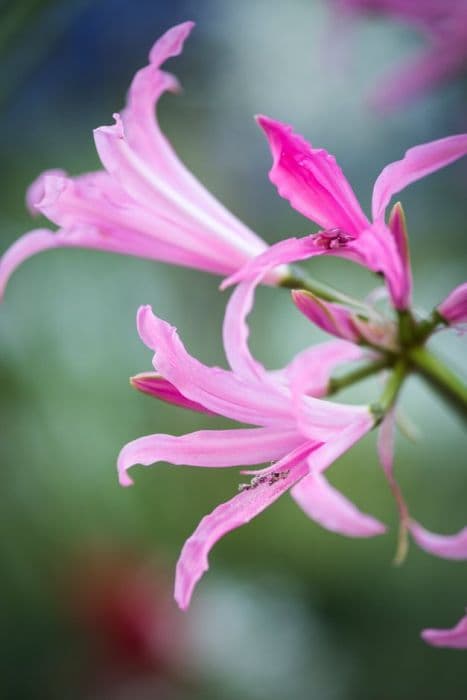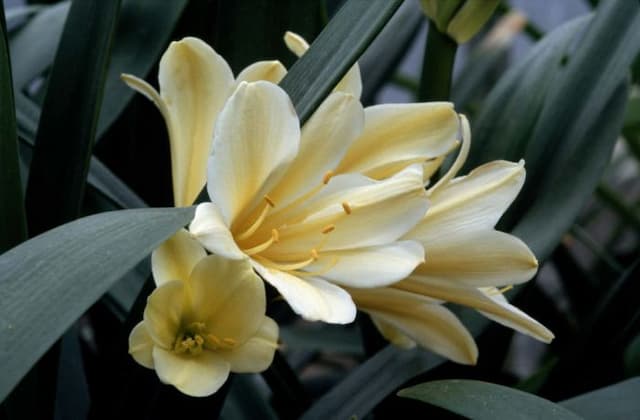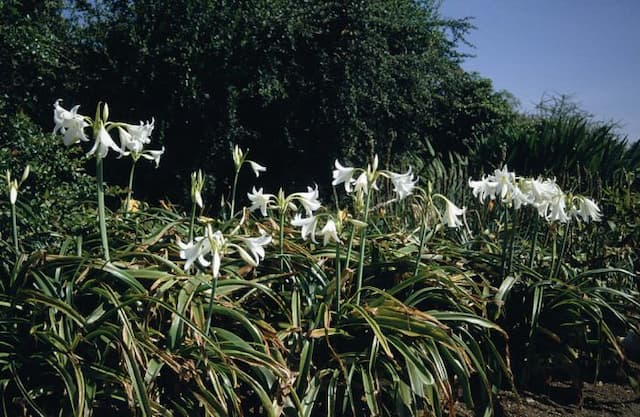Daffodil Narcissus 'Highfire' (2)

ABOUT
The Narcissus 'Highfire' is a striking plant known for its vibrant blooms which are a hallmark of late winter to early spring gardens. This plant showcases beautiful flowers that are typically structured with a central trumpet-shaped corona surrounded by a ring of larger petals. The corona is a vibrant and warm yellow or orange color, and it contrasts with its outer petals, which are often a paler tone of cream or white. This play of colors gives the flowers a fiery appearance, reminiscent of its 'Highfire' name. The blooms are revered for their remarkable symmetry and are borne atop sturdy, upright stalks which emerge from a clump of linear, green leaves that are somewhat narrow and strap-like. These leaves have a slightly arching habit and provide a lush backdrop for the bold, colorful flowers. The fragrance of Narcissus 'Highfire' is another notable feature, with a sweet and pleasant aroma that adds an additional layer of enjoyment to its presence in the garden. This plant is often planted in clusters or drifts, where it creates impressive displays of color and scent. The bulb of the plant, which lies beneath the soil, is the energy store that enables it to produce such vibrant flowers year after year. When in bloom, each flower head faces up or slightly angled to the side, effectively showcasing its beauty and engaging with pollinators such as bees and butterflies. Overall, Narcissus 'Highfire' is a captivating addition to any outdoor space, delivering a bold splash of color and a touch of elegance thanks to its classic floral structure and contrasting hues.
About this plant
 Names
NamesFamily
Amaryllidaceae
Synonyms
Daffodil, Jonquil, Narcissus
Common names
Narcissus 'Highfire'.
 Toxicity
ToxicityTo humans
Daffodils, including the Narcissus 'Highfire', contain toxic alkaloids like lycorine, which can cause symptoms if ingested. The bulb is the most poisonous part, but all parts of the plant are toxic. Ingestion can lead to symptoms such as nausea, vomiting, abdominal pain, and diarrhea. Severe cases may result in cardiac arrhythmias, low blood pressure, tremors, and even seizures.
To pets
Daffodils, such as Narcissus 'Highfire', are toxic to pets. Toxic principles, primarily lycorine and other alkaloids found in all parts of the plant, especially the bulbs, can cause symptoms if ingested. Symptoms in pets may include vomiting, diarrhea, abdominal pain, excessive drooling, and tremors. Severe cases can lead to cardiac arrhythmias, difficulty breathing, and seizures which can be life-threatening.
 Characteristics
CharacteristicsLife cycle
Perennials
Foliage type
Deciduous
Color of leaves
Green
Flower color
Orange-red
Height
1-1.5 feet (30-45 cm)
Spread
0.5-1 feet (15-30 cm)
Plant type
Bulb
Hardiness zones
3-9
Native area
Europe
Benefits
 General Benefits
General Benefits- Decorative Appeal: Narcissus 'Highfire' offers striking blooms that enhance the visual aesthetics of gardens and landscapes.
- Easy to Grow: This daffodil variety is known for being low-maintenance, making it suitable for gardeners of all skill levels.
- Pest Resistance: Daffodils are generally resistant to many pests, reducing the need for chemical treatments.
- Drought Tolerance: Once established, they can tolerate periods of dry weather, conserving water resources.
- Spring Bloom: Narcissus 'Highfire' provides early spring color, often when few other plants are flowering.
- Naturalizing: They can spread over time to create natural-looking drifts of color in the landscape.
- Cut Flower Use: The blooms make for beautiful cut flower arrangements, adding a touch of spring to indoor settings.
- Longevity: Daffodils are perennial and can come back for several years with the right care, providing long-term value.
 Medical Properties
Medical PropertiesThis plant is not used for medical purposes.
 Air-purifying Qualities
Air-purifying QualitiesThis plant is not specifically known for air purifying qualities.
 Other Uses
Other Uses- The bulbs of daffodils can be used to produce a natural dye for fabrics, offering hues ranging from yellow to green, depending on mordants used.
- Pulverized dried daffodil petals can create a natural pigment for artist's paint, providing an alternative to synthetic colors.
- During the Victorian era, daffodil flower essence was sometimes added to bathwater for a fragrant, rejuvenating experience.
- In certain cultures, daffodil flowers are used in ceremonial decorations for celebrations like weddings or religious festivals, symbolizing rebirth and new beginnings.
- Daffodils can serve as an organic pest repellent when grown among crops, as it has been believed to deter rodents due to its toxic properties.
- Daffodil flowers can be used in potpourri blends to contribute a spring-like aroma to indoor spaces.
- In traditional paper-making, fibers from daffodil stems have been explored as a material to create distinctive, textured paper products.
- Daffodil motifs are popular in embroidery and textiles, providing inspiration for patterns and designs in fashion and home decor.
- Dried daffodils can be incorporated into wreaths and other dried floral arrangements for long-lasting natural decor.
- The cup-shaped structure of daffodil flowers has inspired design elements in architecture and functional objects like lamps or water fountains.
Interesting Facts
 Feng Shui
Feng ShuiThe Daffodil is associated with good fortune and prosperity in Feng Shui. It is often recommended to place daffodils in the home during the Chinese New Year to invite wealth, and they can be used in the east sector for health or the southeast for money.
 Zodiac Sign Compitability
Zodiac Sign CompitabilityThe Daffodil is not used in astrology practice.
 Plant Symbolism
Plant Symbolism- Self-love: The name "Narcissus" comes from the Greek myth of Narcissus, who fell in love with his own reflection. The plant is often associated with narcissism or self-love.
- New beginnings: As a flower that blooms in the spring, the Narcissus, often referred to as daffodil, symbolizes renewal and the start of new things.
- Respect: In some cultures, the daffodil is a symbol of respect and can be given to someone who is the only one in your eyes.
- Fortune: In China, daffodils are believed to bring good fortune and are often used in celebrations for the Chinese New Year.
- Vanity: Due to its association with the story of Narcissus, the flower can sometimes represent vanity and excessive self-admiration.
- Chivalry: In medieval times, the daffodil was an emblem of honor and chivalry, representing noble conduct.
- Uncertainty: The daffodil can also stand for uncertainty or unrequited love, possibly deriving from the Narcissus myth where Narcissus does not return the feelings of those who love him.
- Hope: The bright appearance of the daffodil in the spring makes it a symbol of hope and optimism for the future.
 Water
WaterDaffodils, including Narcissus 'Highfire', should be watered thoroughly upon planting and during active growth if the weather is dry. They require about 1 inch of water per week, either from rainfall or supplemental watering. Ensure the soil is well-drained and not waterlogged to prevent bulb rot. During the dormant period after they have finished blooming and the foliage has died back, watering should be reduced significantly. Drought conditions should be avoided especially during the growing season, so providing supplemental water every week to ten days might be necessary, adjusting for rainfall, with the goal of providing the plant with an inch of water over each week period.
 Light
LightDaffodils like Narcissus 'Highfire' thrive in full sunlight to partial shade. The best light conditions for them include at least 6 hours of direct sunlight per day. They perform well when the light is bright but not too intense, so a spot that gets morning sun and afternoon shade is often ideal. Avoiding deep shade is important for the healthy growth and blooming of daffodils.
 Temperature
TemperatureDaffodils, such as Narcissus 'Highfire', can survive a wide range of temperatures. They are hardy and can tolerate winter lows in the range of -20°F to -10°F. The ideal growing temperatures for daffodils are between 50°F and 70°F during the day. They require a cold period for the proper development of their blooms, which makes them perfect for cooler climates.
 Pruning
PruningPruning of daffodils like Narcissus 'Highfire' usually isn't needed, except for removing spent flower heads to promote a tidy appearance and to prevent seed development. Leaves should be allowed to die back naturally and should only be cut back once they have yellowed, which generally occurs about six weeks after flowering. This timing enables the bulbs to store enough energy for the next blooming season.
 Cleaning
CleaningAs needed
 Soil
SoilDaffodil 'Highfire' thrives in well-draining soil with a slightly acidic to neutral pH between 6.0 and 7.0. A good mix would be two parts loam, one part peat, and one part sand or perlite for optimal drainage.
 Repotting
RepottingDaffodils typically do not require frequent repotting and are often replanted every 3 to 5 years unless they become overcrowded.
 Humidity & Misting
Humidity & MistingDaffodil 'Highfire' is tolerant of a wide range of humidity levels but performs best in conditions that replicate its natural outdoor environment, which does not require high humidity.
 Suitable locations
Suitable locationsIndoor
Provide bright, indirect light and cool temps for Daffodils indoors.
Outdoor
Plant bulbs in fall, full sun to partial shade, well-draining soil.
Hardiness zone
3-9 USDA
 Life cycle
Life cycleDaffodil 'Highfire' begins its life cycle with bulb formation, where energy is stored for the upcoming growing season. The bulb enters a period of dormancy during the colder months, conserving energy until conditions are favorable. In early spring, the bulbs break dormancy, initiating the growth of roots and shoots. The plant then develops long, slender leaves and a flower stalk, culminating in the blooming of its characteristic bright flowers, usually in late winter or early spring. After pollination, the flowers fade and seed capsules may form, although cultivated daffodils often propagate vegetatively via bulb offsets rather than seeds. Finally, the foliage dies back as the plant reenters dormancy, completing the cycle and preparing for the next growing season.
 Propogation
PropogationPropogation time
Spring-Early Summer
The most popular method of propagating Narcissus 'Highfire', commonly known as Daffodil, is through division of bulbs. This technique is best done in late summer to early fall, after the foliage has died back but before the ground freezes. To propagate by bulb division, carefully dig up the daffodil clumps with a shovel, ensuring to loosen the soil around the bulbs to avoid damage. Gently separate the bulbs from the main clump, taking care to keep as much of the root system intact as possible. Replant the bulbs immediately at a depth of about 6 to 8 inches (15 to 20 centimeters), allowing sufficient space between them for future growth. Water the newly planted bulbs moderately to help establish them. This method is reliable and straightforward, resulting in a higher success rate for new plants in the following spring.









